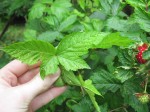 I distinctively remember when I was first introduced to salmonberries by a friend growing up. She showed us how you can bend back the top leaflet in the leaf trio to reveal a butterfly shape. It is a simple way to identify salmonberry bushes. The pink
I distinctively remember when I was first introduced to salmonberries by a friend growing up. She showed us how you can bend back the top leaflet in the leaf trio to reveal a butterfly shape. It is a simple way to identify salmonberry bushes. The pink 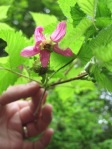 flowers of the plant are a contrasting color against the green of the forest. I always look forward to these berries being the first to ripen in the season. They are not the most delicious berries nature provides, but it is an easily recognizable west coast native edible. The berries have a juicy tang with a modest sweet flavor. A salmonberry jam seemed to be a great idea for a project.
flowers of the plant are a contrasting color against the green of the forest. I always look forward to these berries being the first to ripen in the season. They are not the most delicious berries nature provides, but it is an easily recognizable west coast native edible. The berries have a juicy tang with a modest sweet flavor. A salmonberry jam seemed to be a great idea for a project.
Salmonberry plants are native to the west coast of the United States from California to Alaska. The berries were important to the Native Americans eaten mixed with salmon or roe hence the name Salmonberry. They are said to ripen mid June to Late July. This year spring on the coast was very mild so I found them ripening as early as mid-May. However, they really came into full swing in early June providing me enough berries to can.
 Langdon Cook on the Fat of the Land Blog observed the color of the berries varies from light orange to dark red or purple. I also discovered that each individual plant seemed to have varying leaf and stem shapes. Some of the leaves were narrow and some were broad. A few of the plants had a lot of thorns, although most did not, so I was careful to look where I picked.
Langdon Cook on the Fat of the Land Blog observed the color of the berries varies from light orange to dark red or purple. I also discovered that each individual plant seemed to have varying leaf and stem shapes. Some of the leaves were narrow and some were broad. A few of the plants had a lot of thorns, although most did not, so I was careful to look where I picked.
Being a berry that is very similar to raspberries and thimbleberries, a basic jam recipe can be used. I used the jam recipe from Dot Heggie of Bosky Dell Natives.
Salmonberry Jam
Salmonberries
Sugar
Pectin (optional)
Rinse off the salmonberries and remove any stems, leaves, or moldy pieces. 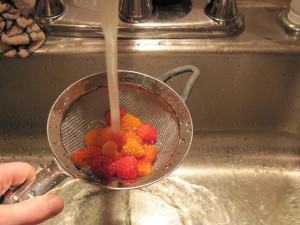 Measure the berries to find out how many cups you have and put them in a sauce pan. Measure out 2/3 cup of sugar for every 1 cup of berries.
Measure the berries to find out how many cups you have and put them in a sauce pan. Measure out 2/3 cup of sugar for every 1 cup of berries.  Use a potato masher to crush the berries. Heat the berries and sugar on medium and stir constantly until the sugar dissolves.
Use a potato masher to crush the berries. Heat the berries and sugar on medium and stir constantly until the sugar dissolves. 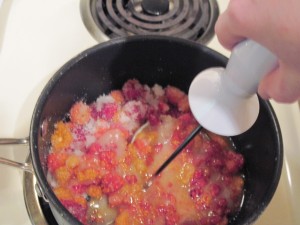 Heat the jam on high to achieve a boil while continuing to stir. Boil until the jam sheets off of a spoon or saucer.
Heat the jam on high to achieve a boil while continuing to stir. Boil until the jam sheets off of a spoon or saucer.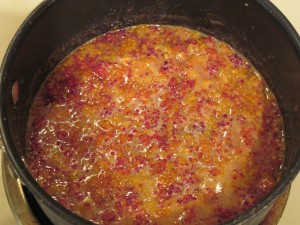 If the jam seems too watery, or if you lose patience, add a tablespoon of pectin. If a foam forms skim it off the top. Spoon the hot jam into the sterilized jars leaving ¼ inch heads space. Tighten the lids down with the bands and boil the jars in water for 10 minutes. Cool the jars on the counter overnight and check the seals in the morning.
If the jam seems too watery, or if you lose patience, add a tablespoon of pectin. If a foam forms skim it off the top. Spoon the hot jam into the sterilized jars leaving ¼ inch heads space. Tighten the lids down with the bands and boil the jars in water for 10 minutes. Cool the jars on the counter overnight and check the seals in the morning. 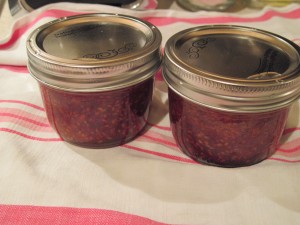
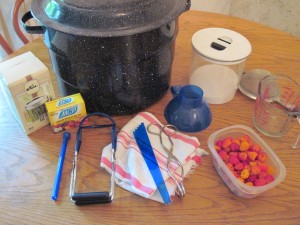
Fun to learn that you can bend back the top leaflet to form a beautiful butterfly shape. Interesting how the berry got its name. I always forget how much sugar goes into jams – no wonder they are so tasty! What is the difference between salmonberries and thimbleberries?
Thimbleberries have very large leaves and white flowers. I love the fruit! If you do a google search for thimbleberries, you can see lots of images to help you identify the plant.
Never heard of salmonberries but now I want some!
Just visit the West coast in late spring and take a hike into the woods. They are a great foraging berry.
There is also a legend that Salmon berries also relate to the salmon run. Salmon berries LOVE to grow next to water… the cleaner the water… the more the berries… the cleaner the water… the more salmon. So its been used as an indicator of the salmon flow in particular areas as well. ❤
though mine grow near no water… but cute thought.
Read somewhere they got their name from traditionally being eaten with salmon eggs by the natives.
Mine do not grow near water, but it was a cute thought.
Salmonberries are called salmon berries because they resemble the salmon’s eggs. They are not necessarily eaten with salmon lol though it is a tastey treat after a salmon dinner for sure!!!
This was super easy to do. Would definitely do it again. ❤ it !
I’m glad that you had success!! Yes, I like doing micro-batches much more than going through a large production.
it takes a looonnngggg time to boil to the right stage. But you DO end up with a great tasting jam…more like a preserve.
You can also use frozen strawberries or raspberries with the salmonberries. Also salmonberries abundantly in Southeast Alaska.
I was wondering if you felt like you need to add anything to bump up the acidity? I am new at this and a little nervous about the acidity level. Thank you!